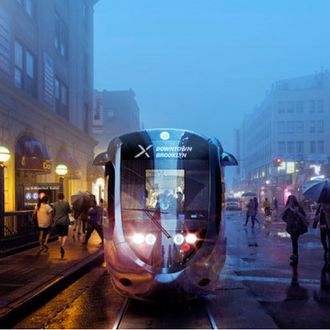
Having lost the fight against Uber and abandoned his plan for a Central Park stable, Bill de Blasio is shifting his transit priorities from one form of 1880s transit technology (the horse-drawn carriage) to another: the streetcar. In his State of the City speech, de Blasio floated a plan for a 16-mile, $2.5 billion trolley line that would run along the waterfront from Sunset Park, through Red Hook and Downtown Brooklyn, past the Navy Yard, all the way to Astoria. It’s the missing piece in the generational project of waterfront development, which has chugged energetically along despite minimal access to public transit. Maybe a waterfront streetcar is an expensive antiquarian folly, but it’s the kind of folly the city needs.
For now, traveling from borough to borough by subway often means a detour through Manhattan. (The G runs direct, but it makes all of two stops in Queens, and the transfer from Court Square to Queensboro Plaza involves a ten-minute walk. The far eastern parts of Queens and Brooklyn are also linked, by the A/C and J/Z, but there are very large areas left unserved.) Existing buses are instruments of slow-motion torture, which is one reason almost nobody takes them. At the moment, the waterfront route is best navigated by bike. A streetcar wouldn’t be speedy — 11 or 12 miles per hour on average — but it would have a dedicated lane, allowing it to glide through gridlock.
I started off as a skeptic. Similar proposals have been kicking around for years — the planner Alex Garvin proposed one, the Bloomberg administration killed another — and my first reaction to this one was that de Blasio is peddling a gentrification fantasy, spraying subsidies at developers who are already swimming in profits. (Specifically, it looked suspiciously like a gift to the developer Two Trees, which owns a lot of property along the route and bankrolled a feasibility study.) Why spend that kind of change helping affluent young Williamsburgers get to their tech jobs in Downtown Brooklyn, I thought, rather than on underserved junctions in the Bronx and Eastern Queens?
The first answer is that the streetcar will be paid for by tax revenue that wouldn’t exist without it. The second is that it does exactly what public transit should: connect homes to jobs, and open up new migration lines. That’s the way New York has developed for 150 years: transit leads development, rather than the other way around. “This is the stretch where we expect to see the most growth in residential construction and jobs,” said deputy mayor Alicia Glen. “There’s a tremendous amount of underutilized and undervalued property there, which makes this project very compelling.”
To pay for the project, the city will rely on tax-increment financing (TIF), in which the city estimates how much additional development the streetcar would generate, then spends projected tax revenues upfront. The assumption is that however much the value of fallow land and vacant warehouses is rising now, better public transit would boost it even more. De Blasio is selling the streetcar as a way to ferry tens of thousands of NYCHA residents to ever-multiplying jobs in the Navy Yard and in the Industry City complex in Sunset Park. That may well happen, and it would be wonderful, but it’s not the reason the streetcar makes sense. Rather, it’s a piston in the machine that moves the city, the engine we call real estate. Property values rise, bringing in more tax revenue, which subsidizes the affordable housing that higher prices make necessary.
The streetcar is also part of the de Blasio administration’s push to create a transit network that doesn’t require the blessing of his nemesis, Governor Andrew Cuomo. The state controls the MTA, which means that building a new subway stop, not to mention a whole line, means going begging in Albany. On the other hand, the city can navigate its streets and waterways any way it likes, which why de Blasio has revived Citi Bike, is launching an expanded ferry system, and is now pushing a streetcar, which would operate as an independent concession. Even as the mayor pumps hundreds of millions of dollars into expanding Select Bus Service along arteries like Woodhaven Boulevard in Queens, he’s also hoping to do an end run on the MTA. (Incidentally, a dedicated bus lane along the waterfront would be cheaper, but because it seems temporary and reversible, it would affect property values only marginally, so there would be less money to build it.)
There are still questions that bear asking, and pitfalls that could mangle the idea beyond recognition. Would developers who stand to gain from this new public amenity be asked to kick in a portion of the budget? Would passengers be able to move seamlessly and on one fare from streetcar to ferry to subway, even if they belong to different systems? And what will all this streetcar-primed development actually look like? The last thing we need is a 16-mile wall of glass slabs like those that have defaced the Williamsburg waterfront, which is why the multiyear approvals process should be linked to humane rezoning. The waterfront is still in the throes of transformation, and stitching it together with a streetcar gives the city a stake in guiding it, rather than just accepting whatever comes along.
Even skeptics can be flexible.






























